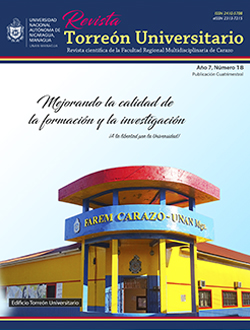Explanations for the presence of atypical patterns of response of a knowledge evaluation test in the FAREM-Carazo
DOI:
https://doi.org/10.5377/torreon.v7i18.7715Keywords:
atypical response patterns, modified precautionary index, knowledge evaluation test, validityAbstract
Test or test type tests provide good academic knowledge acquired by students. Although the tests are designed correctly, with contents representative of the knowledge that is to be evaluated, the results obtained by students who answer the questions atypically can be biased indicators of their levels of knowledge. This possible invalidity of some individual scores can be studied by identifying Atypical Response Patterns (ARP). However, the identification of ARP does not provide information about the causes of it. The objective of this work is to identify some of these possible causes. For this, the answers of a same test of 136 students of three careers taught in the Regional Multidisciplinary Faculty of Carazo, of UNAN-Managua (FAREM-Carazo) have been analyzed. Twenty-six of the students answered atypically, thanks to voluntary interviews with 16 of them; it could be identified as possible explanations for the presence of ARP in the absence of study and the consequent random answers to questions considered difficult or even, in the presence of a response copy. All these reasons justify the doubt about the validity of the scores obtained by those students who gave answers to the test based on aspects different from those of their knowledge in the subject evaluated.
Downloads
Downloads
Published
Issue
Section
License
The authors who publish in this journal agree to the following terms.
- The author or authors of the articles, essays or research grant the National Autonomous University of Nicaragua, Managua (UNAN-Managua) the editing rights (copyright) of the submitted work, therefore the University has the exclusive right to publish the article for the entire copyright period.
- These copyrights/authors authorize Torreón Universitario Magazine and the University to edit and disseminate/publish the article in said Magazine, including printed and electronic reproduction, storage, retrieval and any other type of publication, and sources of secondary information as services. of summaries and databases, they also empower it to protect the article against unauthorized use for dissemination by printed or electronic media (PDF, HTML, EPUB, XML or others).
License for use of content
The magazine uses the Creative Commons Attribution-NonCommercial-NoDerivs 4.0 International License.
Under this statement:

This journal is licensed under a Creative Commons Attribution-NonCommercial-NoDerivatives 4.0 International License. It can be copied, distributed and transmitted publicly as long as the author and source are cited (Revista Torreón Universitario), it should not be modified or used for any commercial purpose. The full license can be found at http://creativecommons.org/licenses/by-nc-nd/4.0/.



